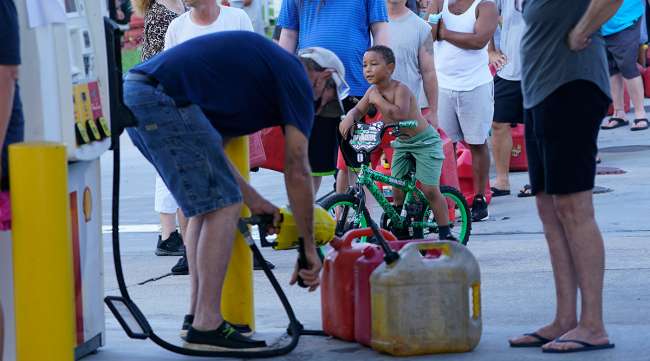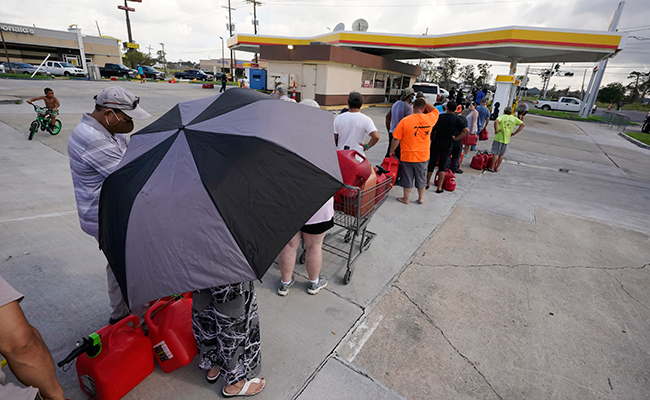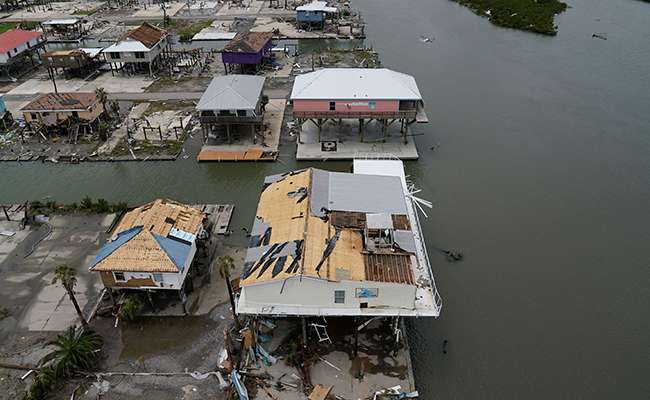In Ida’s Aftermath, No Quick Relief in Sight

[Stay on top of transportation news: Get TTNews in your inbox.]
NEW ORLEANS — Louisiana residents still reeling from flooding and damage caused by Hurricane Ida scrambled Sept. 1 for food, gas, water and relief from the sweltering heat as thousands of line workers toiled to restore electricity and officials vowed to set up more sites where people could get free meals and cool off.
There was a glimmer of hope when power company Entergy announced its crews had turned power on for parts of eastern New Orleans, but did not specify how many homes and businesses had lights. Still, power and water outages affected hundreds of thousands of people, many of them with no way to get immediate relief.
“I don’t have a car. I don’t have no choice but to stay,” said Charles Harris, 58, as he looked for a place to eat Aug. 31 in a New Orleans neighborhood where Ida snapped utility poles and brought down power lines.
Hurricane Ida: Resources and Information #hurricaneida #trucking https://t.co/vOGtkfdAov — LA Motor Transport Assn., Inc. (@TruckinginLA) August 31, 2021
Harris had no access to a generator and said the heat was starting to wear him down. New Orleans and the rest of the region were under a heat advisory, with forecasters saying the high temperatures and humidity could make it feel like 106 degrees on Sept. 1.
New Orleans officials announced seven places around the city where people could get a meal and sit in air conditioning. The city was also using 70 transit buses as cooling sites and was to have drive-thru food, water and ice distribution locations set up on Sept. 1, Mayor LaToya Cantrell said. Distribution locations also were being set up in other parts of the state, the governor said.

People wait in line for fuel in Belle Chasse, La. (Steve Helber/Associated Press)
Ida was the fifth most powerful storm to strike the U.S. when it hit Louisiana on Aug. 29 with maximum winds of 150 mph. The hurricane likely caused $50 billion or more in total damage, Karen Clark of the risk modeling company Karen Clark and Co. told the Associated Press on Sept. 1.
The mayor estimated about half of New Orleans’ population evacuated before Ida struck. Those remaining worked to slowly restore a sense of order. In parts of the city, flags hung from dangling power lines to help drivers avoid them. In one neighborhood, someone decorated the downed lines with strands of tinsel in an echo of Mardi Gras.
One reason to not move around the #Ida impacted area is the strain it has placed on fuel availability. pic.twitter.com/60Vn4o8KNr — Shawn Wilson, Ph.D. (@onevisionary) September 1, 2021
City crews removing debris from roads and cutting up fallen trees had some streets almost completely cleared, while others remained cluttered with obstacles.
A few corner stores were open. Many were taking cash only, though some had working ATM machines. In many areas, National Guard soldiers or law enforcement stood posted at pharmacies and gas stations, where drivers waited in long lines for fuel.
A nighttime curfew in New Orleans took effect Aug. 31 in an effort to prevent crime. Police Chief Shaun Ferguson said there had been some arrests for stealing.
Storm related debris remains on many roadways, and conditions can be hazardous. Don’t drive unless absolutely necessary. If you must drive, please use caution and watch for crews working.
For closure info, visit https://t.co/HeB7jStkTL.
This is LA 21 north of Covington. pic.twitter.com/2ejCuhU3gL — Louisiana DOTD (@La_DOTD) September 1, 2021
Though some lights were back on Sept. 1, a statement from power company Entergy said reconnecting all of New Orleans “will still take time given the significant damage” to the city’s power grid.
The company said it was looking to first restore power to “critical infrastructure” such as hospitals, nursing homes and first responders.
The number of deaths from the hurricane climbed to at least five in Louisiana and Mississippi when Jefferson Parish authorities confirmed a woman was found dead in her home in the community of Lafitte. Jefferson Parish sheriff’s Capt. Jason Rivarde said the woman was found during rescue operations Aug. 30. He gave no further details.
The dead include two people killed Aug. 30 when seven vehicles plunged into a 20-foot-deep hole near Lucedale, Miss., where a highway had collapsed after torrential rains. Gov. John Bel Edwards said he expects the death toll to rise.
Hopes that the New Orleans airport would reopen Sept. 1 were short-lived, with airport officials saying in a statement plans to resume limited flights had been pushed back to Sept. 2. The airport has been closed since the storm hit.
Ida caused massive flooding and structural damage in Houma, LaPlace and other communities outside New Orleans.

The remains of homes are seen in the aftermath of Hurricane Ida in Grand Isle, La., on Aug. 31. (Gerald Herbert/Associated Press)
The barrier island of Grand Isle, which bore Ida’s full fury, is “uninhabitable,” with every building damaged, Jefferson Parish President Cynthia Lee Sheng told a news conference. There were also numerous breaks in the levee system and a strong odor of natural gas, she said.
More than 1 million homes and businesses in Louisiana and Mississippi were left without power when Ida slammed the electric grid, toppling a major transmission tower and knocking out thousands of miles of lines and hundreds of substations.
An estimated 25,000-plus utility workers labored to restore electricity, but officials said it could take weeks.
By Kevin McGill, Chevel Johnson and Melind Deslatte. Deslatte reported from Thibodaux, La. Associated Press writers Janet McConnaughey, Rebecca Santana and Stacey Plaisance in New Orleans; Jay Reeves in Houma, La.; Travis Loller in Nashville; and Sudhin Thanawala in Atlanta contributed to this report.
Want more news? Listen to today's daily briefing below or go here for more info:

